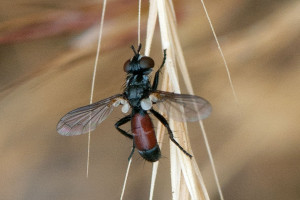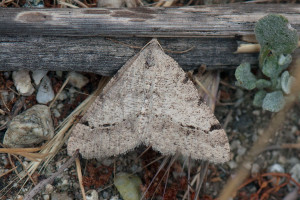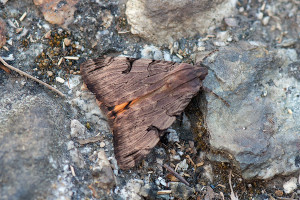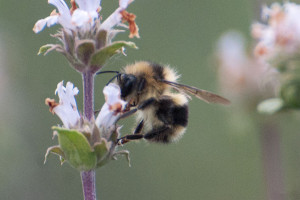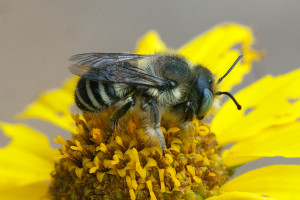We’ve recently added nine new insects to our BFS invertebrate list – one bug, three flies, two moths, one butterfly, and two bees. Here they are:
Bug:
- A rough stinkbug – Brochymena sp. (Hemiptera:Pentatomidae)
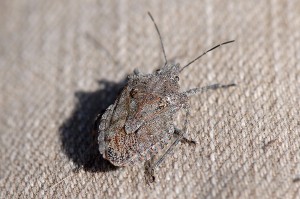
A rough stinkbug, Brochymena sp., found on Mesa Horkelia (Horkelia cuneata ssp. puberula). ©Nancy Hamlett.
Rough stinkbugs, Brochymena sp. occur throughout North America. Rough Stink Bugs are often found on trees, where they are very well-camouflaged against the bark. Like all stink bugs, Brochymena sp. suck juice from flowers, fruit, seed and leaves of plants, but Rough Stink Bugs also prey on caterpillars and other soft-bodied insects and are considered beneficial in the garden because they prey on pests.
Flies:
- A robber fly – Machimus occidentalis (Diptera:Asilidae)
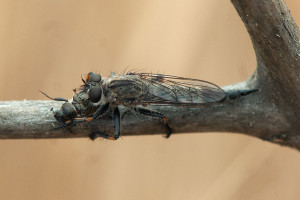
A robber fly, Machimus occidentalis, with a small scarab beetle (Dichelonyx truncata) prey. ©Nancy Hamlett.
Machimus occidentalis is a western species, ranging from California north to Montana and British Columbia, and is reported to be the most common robber fly species along the coast and in low to mid-elevation montane areas of California.
M. occidentalis is usually found in grassy areas, and at the BFS they were seen in a grassy section of the east field. They range freely through their habitats, perching on bare ground or low plants. M. occidentalis takes a wide range of prey, which they capture in mid-air. The one shown here is feeding on Dichelonyx truncata, a small scarab beetle that was common in the area where the robber flies were seen.
- A hover fly – Orthonevra flukei (Diptera:Syrphidae)
Orthonevra flukei ranges from California and Nevada south to tropical Mexico, where it’s typically found on the shore of streams, ponds, or lakes. This one was at the edge of pHake Lake.
- A tachinid fly – Cylindromyia sp. (Diptera:Tachinidae)
Cylindromyia sp. are colorful tachinids that range throughout most of North America, where they are common flower visitors in open weedy areas.
Moths:
- A geometer moth – Digrammia sp. (Possibly D. californiaria) (Lepidoptera:Geometridae)
Moths in the genus Digrammia are found throughout North America. This may be D. californiaria, but several similar species also occur in our area, and we are still waiting for species identification.
- An erebid moth – Drasteria ochracea (Lepidoptera:Erebidae)
Drasteria ochracea is a western species, ranging from California and Arizona north to British Columbia. The abundance of Blue Elderberry (Sambucus nigra ssp. caerulea) makes the BFS a good habitat for this species whose larvae feed only on elderberry (Sambucus spp.).
Butterfly:
- Sleepy Orange – Abaeis nicippe
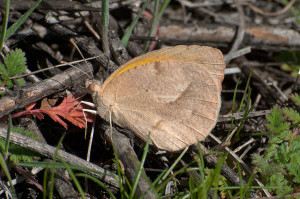
Sleepy Orange, Abaeis nicippe, in mixed grass and coastal sage scrub in the southwest corner of the BFS. ©Nancy Hamlett.
Sleepy Orange butterflies have a rather slow flight, usually close to the ground. Upperside of wings (which are not often visible) are burnt orange, while the undersides are orange-yellow in summer, but brick red, brown, or tan in winter, like the tan one seen here.
Sleepy Oranges range from America and the southern US north to about 40 °N latitude. The larvae feed on Cassia (in the pea family), which does not occur at the BFS, but may be among ornamental plantings in adjacent yards. Adults nectar on a variety of flowers.
Bees:
- Black-tailed Bumble Bee – Bombus melanopygus (Hymenoptera:Apidae)
Black-tailed Bumble Bees are found from California north into Idaho and British Columbia. Interestingly, the bees in the northern part of this range have red hairs instead of black on some of their abdominal segments, and were until recently thought to be a different species. In 2010, however, Robin Owen and colleagues showed that the the two color variants belonged to a single species and that the color difference was determined by a single Mendelian gene. At the BFS Black-tailed Bumble Bees are much less common than Yellow-faced Bumble Bees (Bombus vosnesenskii).
- A leafcutter bee – Megachile (subgenus Megachiloides) (Hymenoptera:Megachilidae)
Megachile (subgenus Megachiloides) occur throughout most of the world, with about 60 species in North Amercia. In the US, more species are found in the western half of the country than in the east. These medium to large bees typically have black bodies and white hairs. The prominent features of this group are their elongate tongues and the females’ unique mandibles, which they use to cut pieces of leaves to seal their nests in the ground.
Taxonomically, the subgenus Megachiloides is of the most problematic Megachile groups in North America. One problem is that males and females of many species have not been associated with each other, leading to a large proportion of species that are described from only one sex. Other problems include outdated identification keys and poorly illustrated descriptions.
References
- Hawkinson, C (2006) “Beneficial Insects in the Garden: #31 Rough Stink Bug” Extension Horticulture at Texas A&M University. http://aggie-horticulture.tamu.edu/galveston/beneficials/beneficial-31_rough_stink_bug.htm
- O’Neill, KM (2001) Observations on the behavior of Machimus occidentalis (Hine) and Machimus formosus (Hine) in Montana. Proc Entomol Soc Wash 103: 222-226. http://www.insectscience.org/10.109/
- Owen, RE, TL Whidden, and RC Plowright (2010). Genetic and morphometric evidence for the conspecific status of the bumble bees, Bombus melanopygus and Bombus edwardsii. J Insect Sci 10: 109.
- Science Daily (4 April 2013) “Let Me Introduce Myself – Leafcutter Bee Megachile chomskyi from Texas” http://www.sciencedaily.com/releases/2013/04/130404122413.htm

